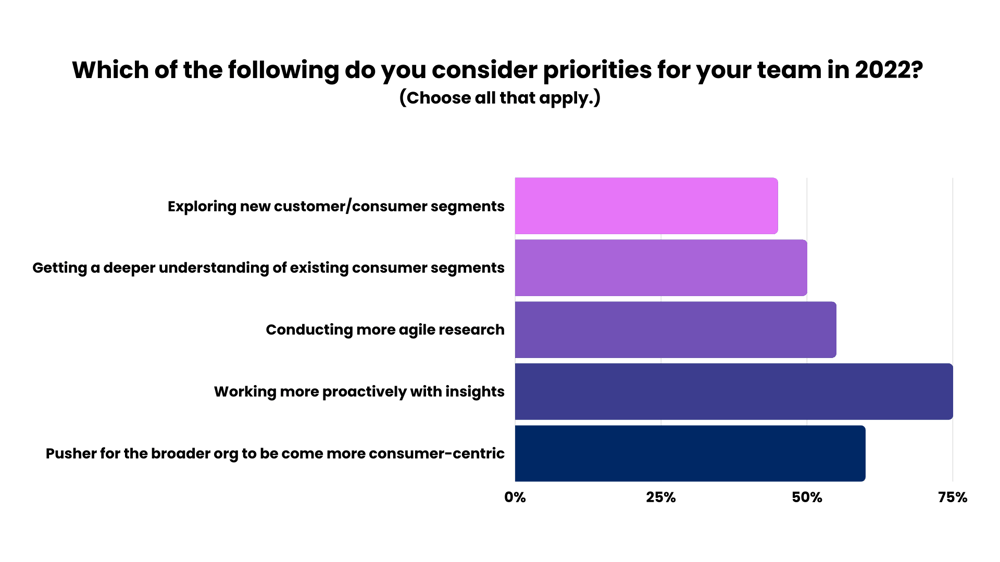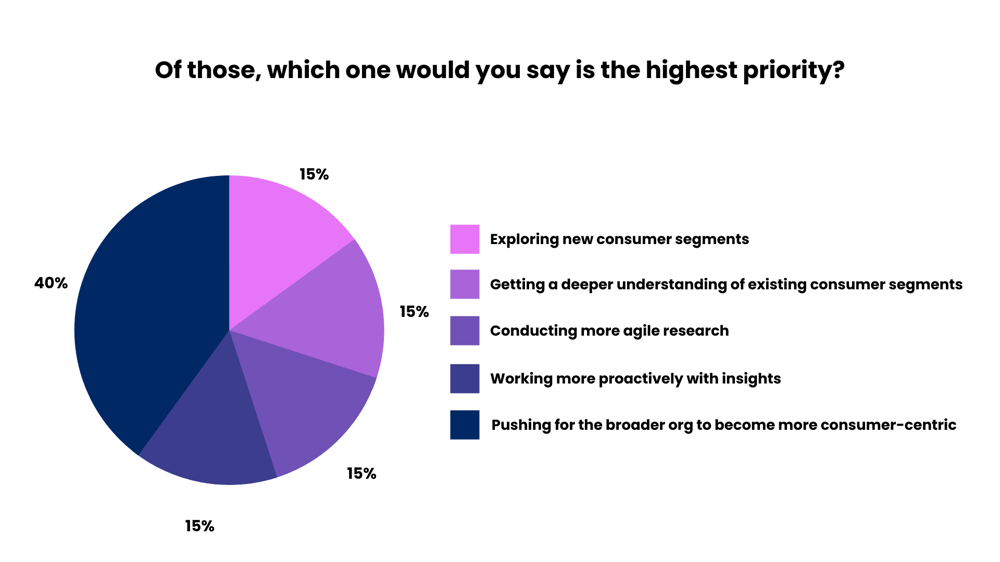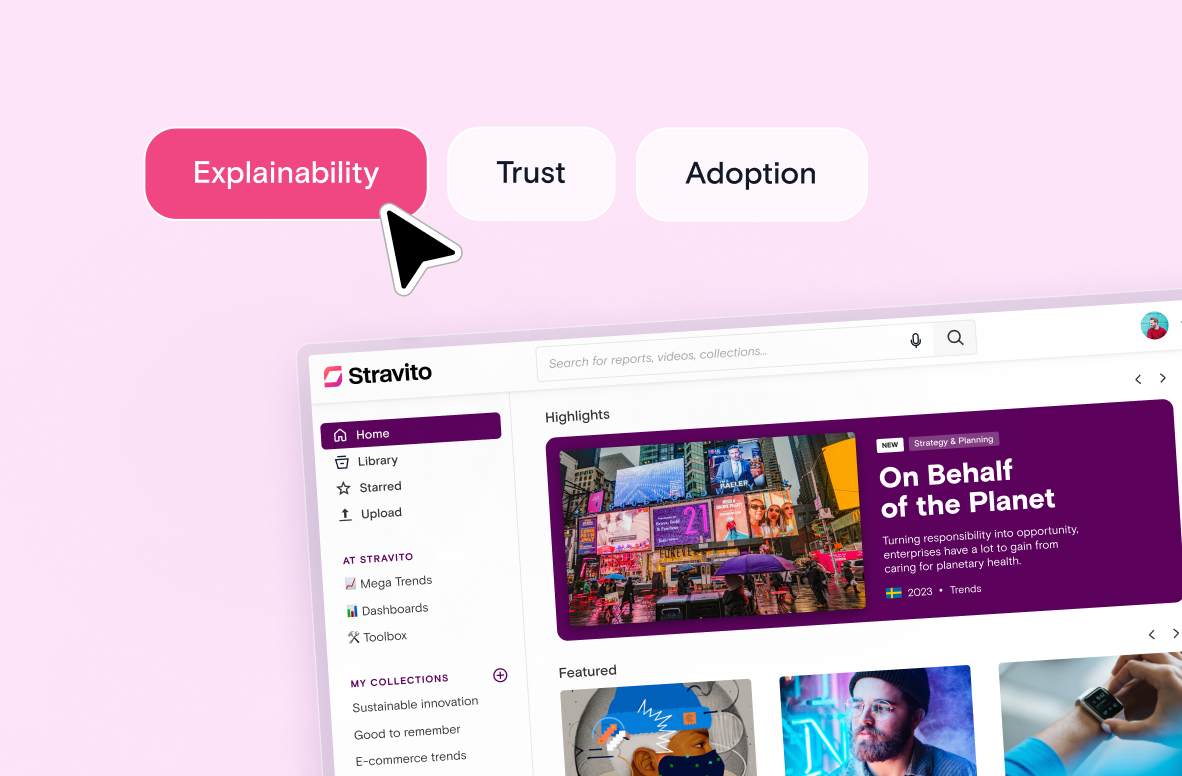For many of us, the start of the year brings with it a sense of possibility and a sense of anticipation.
But if there’s anything the past few years have taught us, it’s that we can’t ever be sure what exactly (or even approximately) to expect.
So without a crystal ball at our disposal, we decided to try the next best thing: a survey.
That’s why, in December 2021, we reached out to insights leaders at 20 different enterprises about working with consumer insights in 2022. We wanted to get an understanding of the challenges they were currently facing, as well as the priorities and changes they saw coming in the year ahead.
Here’s what we learned:
Prediction #1: Crowded to-do lists and increased pressure
Nearly all insight leaders indicated multiple priorities for 2022 which included:
- Exploring new customer/consumer segments
- Getting a deeper understanding of existing customer/consumer segments
- Conducting more agile research
- Working more proactively with insights
- Pushing for the broader organization to become more customer/consumer-centric
90% of respondents named at least 2 priorities for 2022, with 40% naming 3 or more priorities for the year ahead.
The most commonly cited priority, which was included in the answers of 75% of participants, was to work more proactively with insights.

In a recent Harvard Business Review article, Bill Taylor, cofounder of Fast Company and author, describes some of the tension that can be at play here: the need to perform and the need to transform.
The performance need is focused on the short-term – delivering results despite rapid changes in consumer needs and wants, while also navigating the challenges of remote and hybrid work.
The transformation need looks to the future – anticipating how your market will look in the future and envisioning ways to transform organizational culture and strategy to succeed when that future arrives.
So while working more proactively with insights can be seen as a more short-term goal, striving for a more widely consumer-centric organization beyond that is one that requires transforming company culture and strategy.
The needs to perform and transform will place the spotlight on insights teams, amping up the pressure but also creating more opportunity to make an impact.
Prediction #2: Consumer centricity in the spotlight
While working more proactively with insights was most commonly cited by respondents when we asked them to name all possible priorities, the results were different when we asked them to choose just one.

40% answered that pushing for the broader organization to be more customer or consumer-centric. However, there were obstacles still standing in the way.
The most common current challenges, cited by 60% and 75% of survey respondents respectively, were:
1) that it was difficult to find research/insights that they knew they had (60%)
2) a high volume of requests from stakeholders (75%)
Both of these challenges eat up precious time that could otherwise be spent on more proactive insights work.
On top of the insights-specific challenges named in the survey, there are also more general obstacles to take into account.
For example, consultants and co-authors, Lisa Earle McLed and Elisabeth Lotardo have noticed with several of their clients that remote and hybrid work environments have led to an increasing disconnect with customers, particularly for non-customer-facing teams. One of the leaders they talked to summarized it eloquently:
“We used to start meetings talking about customers. Now we hardly mention them at all.”
The reason? Without chances for informal socializing around the office, interactions between customer-facing and non-customer-facing teams have become less frequent.
Customer or consumer centricity (depending on what term you prefer to use) in the broader organization looks to be both more challenging and more important than ever in 2022.
Prediction #3: Insights democratization is just getting started
Given that to-do lists are crowded, time is limited, and consumer centricity is a top priority, it’s no surprise that increasing self-service access and cross-team collaboration are expected focus areas in the year to come. Both were tied for being the most commonly anticipated changes to insights work in 2022, cited by 60% of respondents.
Both self-service access and cross-team collaboration are closely tied to insights democratization. Because at its core, insights democratization is about empowering stakeholders to access, process, and apply insights in a way that can be sustained over the long term.
Thus, self-service access for stakeholders is a foundational element of democratizing insights in an organization.
Cross-team collaboration is where insights democratization starts to impact output. When stakeholders across teams outside of insights can apply the latest insights to their subject area expertise, they then create an essential part of the consumer centricity puzzle.
And when stakeholders come together to assemble those pieces, the result is consumer-centric innovation of the highest caliber.
How to prepare for the year ahead
With the predictions above in mind, we’ve put together a list of action items that can help your team prepare for consumer insights work in 2022.
Action Item #1: Rethink jobs to be done
Take the opportunity to not just reconnect with your consumers/customers, but to enhance the quality of quality of connections and explore new ways to connect. One way to do this is by revisiting the different types of jobs to be done: functional, emotional, social, and aspirational.
While functional jobs focus on an actual task to accomplish or a problem to solve, the other three focus on more abstract elements. Emotional jobs relate to how your customers want to feel, and social jobs relate to how they want to be seen. Aspirational jobs go a step further and look at who your customers want to become, in the short or long term.
This could involve reviewing existing research and insights with fresh eyes, or it might mean commissioning new studies that probe deeper.
However you choose to do it, refreshing your team and stakeholders on what you’re trying to help your consumers achieve is a great way to ensure your consumer centricity initiatives start the year out strong.
Action item #2: Declutter with purpose
In the spirit of jobs to be done, revisit yours. What do you want to achieve this year? What does your team want to achieve this year? Try to be as purposeful as possible when planning out your schedule, and remember the needs to transform and perform when doing so.
But of course, in order to make room for more proactive insights work, it’s essential to find ways to cut out the clutter. Audit your schedule with a special focus on two areas: 1) the repetitive tasks that add up and 2) the ones that take significant chunks of time.
For example, each individual stakeholder request for insights might not seem like it takes a lot of time. But when you’re experiencing a high volume of stakeholder requests, it can disrupt your day and prevent you from getting to the more important things.
You can try to get ahead of it with more proactive insights communication (i.e. a bi-weekly newsletter to stakeholders) or by increasing self-service access so that stakeholders can more easily help themselves.
Action item #3: Invest in the right insights tech
When we asked survey respondents about some of the ways they planned to achieve their priorities in 2022, the most common answer was investing in new research or insights technologies, which was included in the responses of 60% of participants.
And it makes sense. In order to increase self-service access, free up time to work more proactively with insights, and to ensure that everyone is getting closer to consumers, the right technological support is crucial.
But of course, making that investment is often easier said than done. For example, a PwC survey found that 53% of companies have yet to realize substantial value from their cloud investments.
In order to get more value from your insights tech investments, it’s crucial to focus on the outcomes that this technology is supposed to help achieve, and in particular the outcomes for your customers.
Entering the age of consumer insights
The uncertainty of the last couple years has highlighted a tremendous need for consumer understanding – and therefore, a tremendous need for consumer insights teams.
On a business level, it’s clear that leveraging insights has proven to be more important than ever. The ability to quickly adapt to shifting consumer needs and to create offerings that are centered around these needs have shown to be essential for business success.
But on a broader level, these past two years have highlighted a need for understanding others. Nearly all of us have been impacted in some way, and remembering that can help us navigate the months to come with more empathy and compassion.
The best consumer insights teams dedicate themselves to gaining a deep intuition for the needs, wants, hopes, and aspirations of consumers.
And that’s something we can all learn from.


.png?width=1200&name=2021%20Blog%20CTAs%20(7).png)


